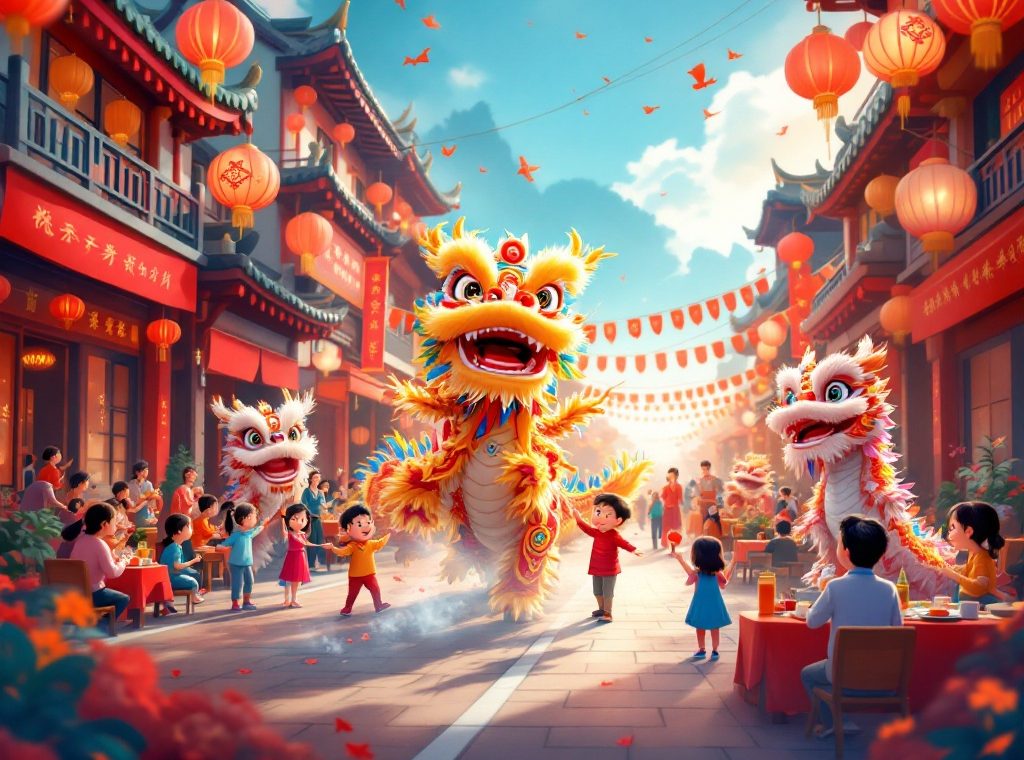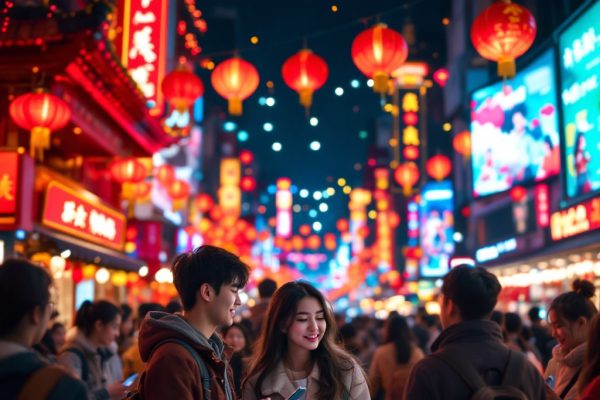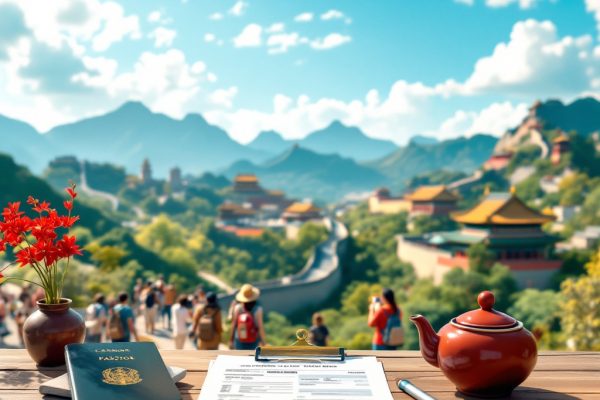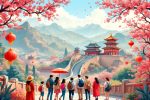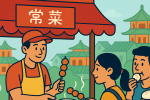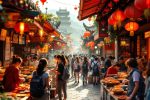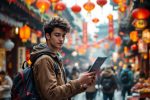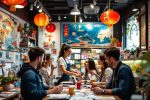Immersing Yourself in Culture: Fun Activities for Chinese New Year
Journey through 3,500 years of tradition with the vibrant celebration of Chinese New Year! From symbolic dishes like dumplings and fish to the energetic Lion and Dragon dances, discover the rich cultural heritage of the Spring Festival. Explore family-friendly activities, learn how to organize a traditional reunion dinner, and even craft your own lucky decorations. Uncover the meaning behind red envelopes and the Chinese zodiac. Dive into this immersive experience and enrich your understanding of this exciting celebration – start exploring today!
Important information

- Chinese New Year, also known as Spring Festival, is a 15-day celebration focused on family, traditions, and hopes for prosperity.
- Key traditions include lion and dragon dances, elaborate feasts with symbolic dishes (dumplings for wealth, fish for abundance), giving red envelopes (Lai See) filled with money for good luck, and decorating homes with red ornaments, lanterns, and couplets.
- Families gather for reunions, particularly the New Year’s Eve dinner, and participate in activities like making lanterns, crafting dragons, and playing traditional games.
- Public celebrations often feature parades, firecracker ceremonies, and cultural events in Chinatowns across the world.
- The Chinese zodiac plays a significant role, with each year represented by an animal and associated with specific attributes.
Understanding the Significance of Chinese New Year
The Chinese New Year, also known as the Spring Festival, is a vibrant 15-day cultural celebration with a history spanning over 3,500 years. Originating in the Shang Dynasty, it revolves around family, ancient customs, and hopes for a prosperous year ahead. It’s a time of renewal, casting off negativity and embracing positivity. Values such as peace, health, longevity, and luck take center stage.Families gather for reunions, enjoying special foods and cleansing their homes to welcome the new year. Temples become central hubs of activity, while the vibrant energy of fireworks and lion dances fills the air, symbolizing the warding off of evil spirits and the welcoming of the new year.Understanding these traditions promotes diversity and inclusion, enriching workplace celebrations and demonstrating respect for cultural heritage. Adding another dimension, horoscopes based on the Chinese zodiac offer insights and predictions for the coming year. For instance, 2024, the year of the wood dragon, is associated with abundance.
Exploring Cultural Rituals and Traditions
Chinese New Year is a vibrant celebration steeped in tradition. Lion and dragon dances wind their way through the streets, accompanied by the joyful crackle of firecrackers. Families gather for elaborate feasts, the most important of which is the New Year’s Eve dinner. Symbolic dishes, such as dumplings representing wealth and fish signifying abundance, adorn the table. Children and unmarried adults receive red envelopes filled with money, a symbol of good fortune. Homes are decorated with red ornaments, and lanterns and couplets hang from doorways to invite good luck and ward off evil. These customs all share a common theme: the pursuit of prosperity, good fortune, and protection in the new year.
Engaging Family-Friendly Activities
Family meals offer a wonderful opportunity to connect, sharing stories and strengthening bonds. Exploring cultural activities, such as vibrant dragon dances, deepens everyone’s understanding of the Lunar New Year.
- Transform a corner of your home into a pretend restaurant, fostering creativity and imagination.
- Give lucky red envelopes filled with heartfelt messages or small gifts to encourage generosity.
- Paint decorative fans and play games with chopsticks to stimulate creativity and develop fine motor skills.
Enhance the festivities with educational activities:
- Make colorful lanterns.
- Learn basic Mandarin phrases.
- Craft dancing dragons.
- Simulate a panda habitat or reenact the legendary Great Race to immerse children in Chinese culture.
Enjoy traditional games and activities:
- Play Jianzi or Mahjong to entertain and connect generations.
- Organize a scavenger hunt featuring New Year symbols for added excitement.
- Play card games incorporating lucky numbers, a popular pastime.
Encourage children to participate by:
- Making paper lanterns.
- Crafting red envelopes.
- Creating dragon-themed artwork.
- Helping with decorations.
- Participating in lion dances.
- Cooking simple dishes.
- Practicing calligraphy for hands-on experiences.
For an immersive experience, attend cultural events:
- Experience the vibrant Lunar New Year Parade in Chinatown.
- Witness the exciting Firecracker Ceremony.
- Enjoy Lincoln Center’s family celebration.
- Explore interactive activities like candy making and noodle pulling at the Museum of Chinese in America.
- Participate in Lunar New Year Family Days at other museums, featuring arts and crafts, cooking classes, and captivating storytelling.
How to Organize a Traditional Reunion Dinner
Select a date and time for your gathering.
Compile your guest list and send out invitations.
Plan the menu, considering symbolic foods like dumplings for wealth and noodles for longevity, but also be mindful of any dietary restrictions your guests may have.
Delegate tasks such as cooking, setting up, and cleaning to lighten your load.
Prepare icebreaker games to encourage interaction.
Create a festive atmosphere with decorations and music.
Capture the memories with photos and videos.
Relax and enjoy celebrating with your loved ones.
The Role of Symbolic Dishes in Celebrations
Dumplings, symbolize wealth, while fish signifies abundance for the coming year.
Noodles symbolize longevity.
Rice cakes represent growth and progress.
Sweet treats like oranges and tangyuan (sweet dumplings) are enjoyed to symbolize family togetherness.
A traditional New Year’s lunch often includes dishes like prosperity salad (Yusheng), adding to the symbolic richness of the meal.
Exploring the Tradition of Lucky Red Envelopes
Lai See, red envelopes given during Chinese New Year, symbolize good luck and prosperity. Married couples and elders typically present these tokens of good fortune to children and unmarried adults. The color red itself represents happiness and is believed to ward off evil spirits. The money enclosed signifies blessings for the upcoming year, strengthening family bonds and sharing prosperity within the community. Auspicious numbers, such as 6 or 8, often determine the amount gifted, further enhancing the symbolic meaning. This traditional exchange fosters generosity and promotes cultural understanding.
Interactive Cultural Activities for Kids
Craft vibrant paper lanterns, symbols of good luck and prosperity. This activity also boosts fine motor skills. Kids will delight in creating these colorful decorations.
Fashion dancing dragons, introducing the iconic symbol of Chinese New Year. This fosters both creativity and cultural awareness. This hands-on activity is sure to be a hit.
Re-enact the legendary Great Race, teaching children about the Chinese zodiac animals and their order. This imaginative play encourages storytelling and provides an engaging educational experience.
Crafting Paper Lanterns for Good Fortune
Celebrating Chinese New Year with handmade paper lanterns is a fun and educational activity for kids. Using simple materials like colored paper, scissors, glue, and string, children can express their creativity while developing fine motor skills through folding, cutting, and assembly. Decorating the lanterns offers a chance to explore cultural elements, such as incorporating the character for “good fortune” (福) or images of zodiac animals, enriching the learning experience. This craft beautifully combines creative expression, cultural understanding, and practical skill development.
Benefits for Kids
- develops fine motor skills,
- encourages creative expression,
- promotes cultural understanding.
Materials Needed
- colored paper,
- scissors,
- glue,
- string.
Making Dancing Dragons: A Craft Activity
Create a dazzling dancing dragon using common household items!
Gather your materials: toilet paper rolls, paint, colorful tissue paper, string, and chopsticks or straws.
Decorate the toilet paper roll with vibrant paints and exciting designs to create your dragon’s body.
Cut strips of colorful tissue paper and glue them to one end of the roll to form the dragon’s fiery breath.
Attach a string to the dragon’s body, allowing you to control its movements.
Twirl the string around a chopstick or straw and make your dragon dance.
This craft project sparks creativity, provides hours of fun, and even offers a glimpse into different cultures.
Re-enacting the Great Race: Understanding the Chinese Zodiac
Bring the story of the Chinese Zodiac to life with the Great Race, an interactive adventure perfect for sparking your child’s imagination. Kids can use puppets or toys to represent the animal racers, creating a “river” racetrack to act out the story and learn the zodiac animals in order. Crafting masks or headbands adds another layer of fun, reinforcing their learning in an engaging and enjoyable way.
Creative Arts and Crafts for New Year Celebrations
Red and yellow, symbolizing good fortune and prosperity, are the dominant colors of Chinese New Year decorations. Vibrant paper lanterns represent light and hope. Red envelopes filled with money symbolize good luck and are given as gifts. Auspicious couplets, often adorned with zodiac animals for a personal touch, decorate doorways and offer blessings for the new year. Creating these decorations provides a hands-on connection to cultural traditions.
Door couplets, written on red paper, express wishes for the new year and invite good luck and happiness. Plum blossoms, symbolizing resilience and new beginnings, frequently appear in seasonal displays, alongside deities associated with good fortune. The creation of these decorations is a meaningful family tradition, strengthening bonds and passing down cultural knowledge.
Making Red and Yellow Decorations
Chinese New Year decorations are overflowing with lively reds and yellows, symbolizing good fortune and happiness. These colors decorate everything from detailed paper cuttings and lanterns to complex knots displayed on doors and windows.
A wealth bowl full of coins and oranges further improves the festive atmosphere, inviting prosperity into the home. Creating these decorations together is a beloved family tradition, amplifying the joyous celebration.
Creating Door Couplets and Seasonal Displays
Many homes display door couplets brimming with New Year’s greetings. Families also decorate with symbolic items like paper cuttings, intricate knots, and vibrant lanterns to celebrate the season.
Experiencing Cultural Performances and Events
Experience the vibrant energy of the Lion Dance, a traditional performance symbolizing good luck and prosperity. Dancers in elaborate costumes captivatingly mimic a lion’s movements.The Dragon Dance is another mesmerizing New Year’s tradition. A long, colorful dragon, controlled by numerous people, weaves through the streets, bringing good fortune and warding off evil.Explore the cultural richness of Chinatown, especially during Chinese New Year. Adorned with lanterns, the streets offer traditional foods, unique souvenirs, and various cultural activities, creating a truly immersive experience.
Watching or Performing a Lion Dance
Lion dances are a thrilling Chinese New Year tradition, believed to bring good luck and prosperity. Energetic dancers, clad in vibrant lion costumes, move rhythmically to the beat of drums and cymbals. This lively music and dance wards off evil spirits, adding excitement to the festivities. Families can enjoy watching professional troupes or even participate in community lion dances.
Attending Dragon Dance Performances
Dragon dances, potent symbols of strength and good fortune, form a vibrant cornerstone of Lunar New Year festivities. Believed to banish evil spirits, these captivating performances also herald a prosperous year ahead. Often accompanied by the energetic beat of drums and cymbals, the dances create a truly festive atmosphere.
Walking Through Chinatown: A Cultural Immersion
Lunar New Year transforms Chinatown into a vibrant spectacle. Streets explode with colorful, festive decorations, while dragon and lion dances weave through bustling crowds. The crackle of firecrackers adds to the electrifying atmosphere. Enjoy the festivities from a distance, or find a quieter vantage point beneath an archway for a unique perspective on the rich traditions of this unforgettable celebration.
Participating in Educational and Team Activities
Celebrate the Lunar New Year with a fun trivia contest! This engaging activity is a great way to promote teamwork and learn about the holiday’s rich history, vibrant traditions, and cultural significance. It’s the perfect opportunity to connect with colleagues, foster a more inclusive workplace, and celebrate together. Test your team’s knowledge and gain valuable insights into this important celebration.
Organizing Cultural Trivia Games
Celebrate the Lunar New Year with a captivating trivia game. It’s a fun way to learn about this vibrant holiday. Teams can test their knowledge of the history, customs, and cultural significance. This interactive game is both educational and entertaining, making it a great team-building activity.
Sample Trivia Questions
- What symbolic foods are often eaten during Lunar New Year?
- How many animals are in the Chinese zodiac?
- What is the significance of giving red envelopes?
Benefits of the Game
- Fun and engaging way to celebrate.
- Educational: Learn about the holiday’s history and customs.
- Great for team building: Encourages collaboration and friendly competition.

